Russel Brothers Limited OWEN SOUND, ONTARIO Steelcraft Boat Builders
 |  |
|
| Glenevis
Particulars of Canadian War Vessels Building & Projected by, Naval Service Headquarters (D. N. C. Dept.) 1943 - 1945: Glenevis [C.N.890] built by Russel Bros. Ltd., Owen Sound, Ontario. Canadian List of Ships 1994: Steel tug Glenevis [C.371772] registered at Hamilton. Built at Owen Sound in 1944. She measures 75�; 90 g.t.: 19 n.t. After sinking at Pugwash, NS, January 1, 1991, she was completely rebuilt. Owned by McKeil Work Boats Ltd., Hamilton, Ontario. Transport Canada List 2003: Owned by Mckeil Work Boats Ltd., Hamilton, Ontario. Sent to Nassau, Bahamas 2007.
The first Glenevis (CN 890, W.65, YTB 502) was built by Russel Brothers in Owen Sound, ON in 1944 and served the RCN until 1979. McKeil Workboats of Hamilton, ON purchased the tug, and replaced its 400 bhp engine with 900 bhp, converting is from single to twin screw.
McKeil did not rename the tugs, and its RCN replacements used the same name, thus creating the unusual situation of two vessels of the same name operating in Halifax at the same time. Since naval vessels are not registered the way private vessels are, there is no requirement for their names to be unique. Private vessels may not have the same name as a vessel already on the register, so this does not apply to naval vessel names.
On January 1, 1991 Glenevis sank at its berth in Pugwash, NS, but was raised on January 9. A major rebuild included a new raised wheelhouse with captain's cabin. The tug lasted in McKeil service until June, 2007 when it was sold to Caribbean owners and sailed through the Erie Canals to Long Island Sound. |
From the book UNDER TOW: A HISTORY OF TUGS AND TOWING
by Donal M. Baird, page 97. 
|
 |
The Gazette
Montreal, Quebec, Quebec, Canada
18 Feb 1949, Fri Page 23.
House Briefs Ottawa, Feb. 17. Defence Minister Claxton said today in the Commons that the harbor craft and ferries which collided recently in Halifax were not equipped with radar. "So far it has not been considered necessary to install radar in these circumstances," he said. He was replying to D. King Hazen (PC St. John-Albert), who asked last week if radar equipment was in the naval tug Glenevis, which collided with the Halifax-Dartmouth ferry, and the Harbor craft No. 303. which collided with the North Dartmouth ferry. |
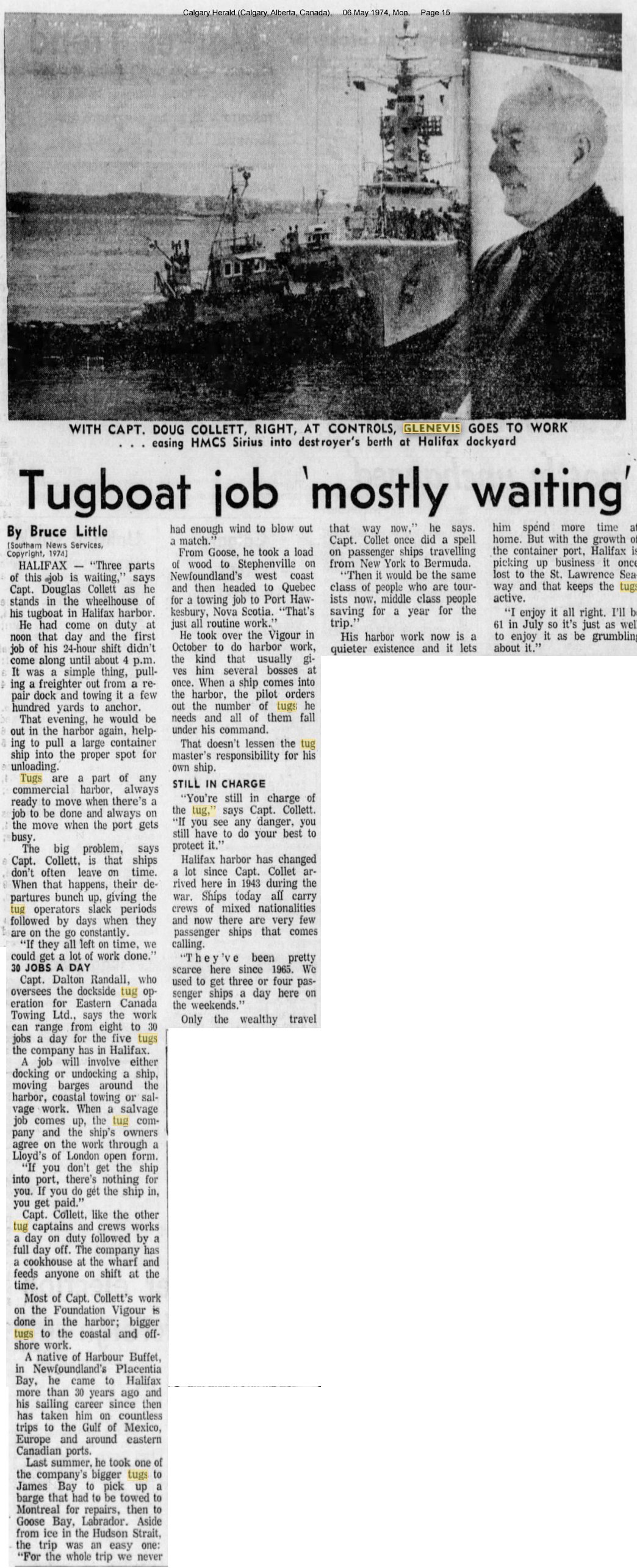 |
Calgary Herald
Calgary, Alberta,
06 May 1974, Mon Page 15
TUGBOAT JOB 'MOSTLY WAITING'
By Bruce Little (Southam News Services, Copyright, 1974) HALIFAX - "Three parts of this job is waiting," says Capt. Douglas Collett as he 5 stands in the wheelhouse of his tugboat in Halifax harbor. He had come on duty at noon that day and the first job of his 24-hour shift didn't come along until about 4 p.m. It was a simple thing, pulling a freighter out from a repair dock and towing it a few hundred yards to anchor. That evening, he would be be out in the harbor again, helping to pull a large container ship into the proper spot for unloading.
Tugs are a part of any commercial harbor, always ready to move when there's a job to be done and always on the move when the port gets busy. The big problem, says Capt. Collett, is that ships don't often leave on time. When that happens, their departures bunch up, giving the tug operators slack periods followed by days when they are on the go constantly. "If they all left on time, we could get a lot of work done."
30 JOBS A DAY Capt. Dalton Randall, who oversees the dockside tug operation for Eastern Canada Towing Ltd., says the work can range from eight to 30 jobs a day for the five tugs the company has in Halifax. A job will involve either docking or undocking a ship, moving barges around the harbor, coastal towing or salvage work. When a salvage job comes up, the tug company and the ship's owners agree on the work through a Lloyd's of London open form. "If you don't get the ship into port, there's nothing for you. If you do get the ship in, you get paid." Capt. Collett, like the other tug captains and crews works a day on duty followed by a full day off. The company has a cookhouse at the wharf and feeds anyone on shift at the time.
Most of Capt. Collett's work on the Foundation Vigour is done in the harbor; bigger tugs to the coastal and offshore work. A native of Harbour Buffet, in Newfoundland's Placentia Bay, he came to Halifax more than 30 years ago and his sailing career since then has taken him on countless trips to the Gulf of Mexico, Europe and around eastern Canadian ports. Last summer, he took one of the company's bigger tugs to James Bay to pick up a barge that had to be towed to Montreal for repairs, then to Goose Bay, Labrador.
Aside from ice in the Hudson Strait, the trip was an easy one: "For the whole trip we never had enough wind to blow out a match." From Goose, he took a load of wood to Stephenville on Newfoundland's west coast and then headed to Quebec for a towing job to Port Hawkesbury, Nova Scotia. "That's just all routine work." He took over the Vigour in October to do harbor work, the kind that usually gives him several bosses at once. When a ship comes into the harbor, the pilot orders out the number of tugs he needs and all of them fall under his command. That doesn't lessen the tug master's responsibility for his own ship.
STILL IN CHARGE "You're still in charge of the tug," says Capt. Collett. "If you see any danger, you still have to do your best to protect it." Halifax harbor has changed a lot since Capt. Collet arrived here in 1943 during the war. Ships today all carry crews of mixed nationalities and now there are very few passenger ships that comes calling. "They've been pretty scarce here since 1965. We used to get three or four passenger ships a day here on the weekends." Only the wealthy travel that way now," he says.
Capt. Collet once did a spell on passenger ships travelling from New York to Bermuda. "Then it would be the same class of people who are tourists now, middle class people saving for a year for the trip." His harbor work now is a quieter existence and it lets him spend more time at home. But with the growth of the container port, Halifax is picking up business it once lost to the St. Lawrence Seaway and that keeps the tugs active. "I enjoy it all right. I'll be 61 in July so it's just as well to enjoy it as be grumbling about it." |
Glenlivet II (left) and Glenevis, Halifax, May 1977. Photo by Mac Mackay.
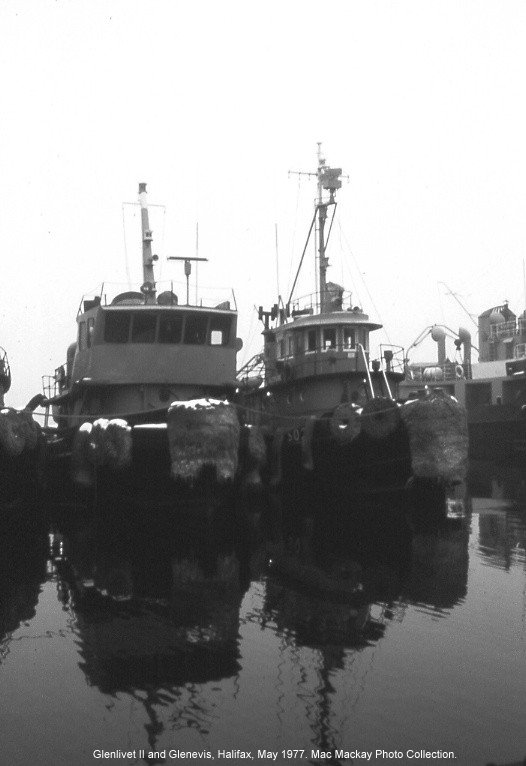 |
Glenevis Feb. 20, 1977. Photo courtesy Mac Mackay. A pair of first generation Glen tugs at HMC Dockyard shortly while still in naval auxiliary service. Note the elaborate pudding fenders. These masterpieces of ropework were once common on tugs and sailors made them up out of old rope. Even after old tires became the standard for fendering, the Dockyard's rope shop "embroidered" the tires to give them the desired characteristics. These included reduced scuff marks (black smears on navy grey hulls were not desired!) and better friction on contact - not to mention appearance.
source: http://tugfax1.rssing.com/chan-8304477/all_p18.html
GLENEVIS in Pugwash, N.S., June 5, 1978.
Photo by Rene Beauchamp.
Comments (April 2018)...Donnie Smith: "That was about the same place it was when she went down, only facing the other way". Tim McKiel: "This pic must be during the run up to Hamilton when the tugs were first purchased by McKeil. Gerry Lambert cut away piping like mad making a pile on the deck plates with no thought for what might be done, at least that is how Doug viewed it, and I recall chipping the paint away a few inches above the main deck, all around the raised engine room coaming, inside and out, where we were going to cut it away. Blair, myself and Don MacRae."
GLENEVIS in the Montreal area, Aug., 1985.
Photo by Rene Beauchamp. 
|
Glenevis Oct. 25, 1986 still in RCN configuration. It was later modified with a new wheelhouse and captain's cabin. McKeil Workboats acquired three navy Glens: Glenbrook, Glenevis and Glenside in 1979, keeping the original names, but modifying the tugs over time with new wheelhouses and propulsion modifications.
source: http://tugfaxblogspotcom.blogspot.ca/2013/05/first-generation-glen-class-tugs-of-rcn.html
GLENEVIS in the St. Lawrence Seaway, C�te Ste. Catherine area, near Montreal, on Sept. 2, 1987.
She was towing a US laker at that time on her way to a shipbreaking yard overseas.
McKeil Work Boats. Photo by Rene Beauchamp. 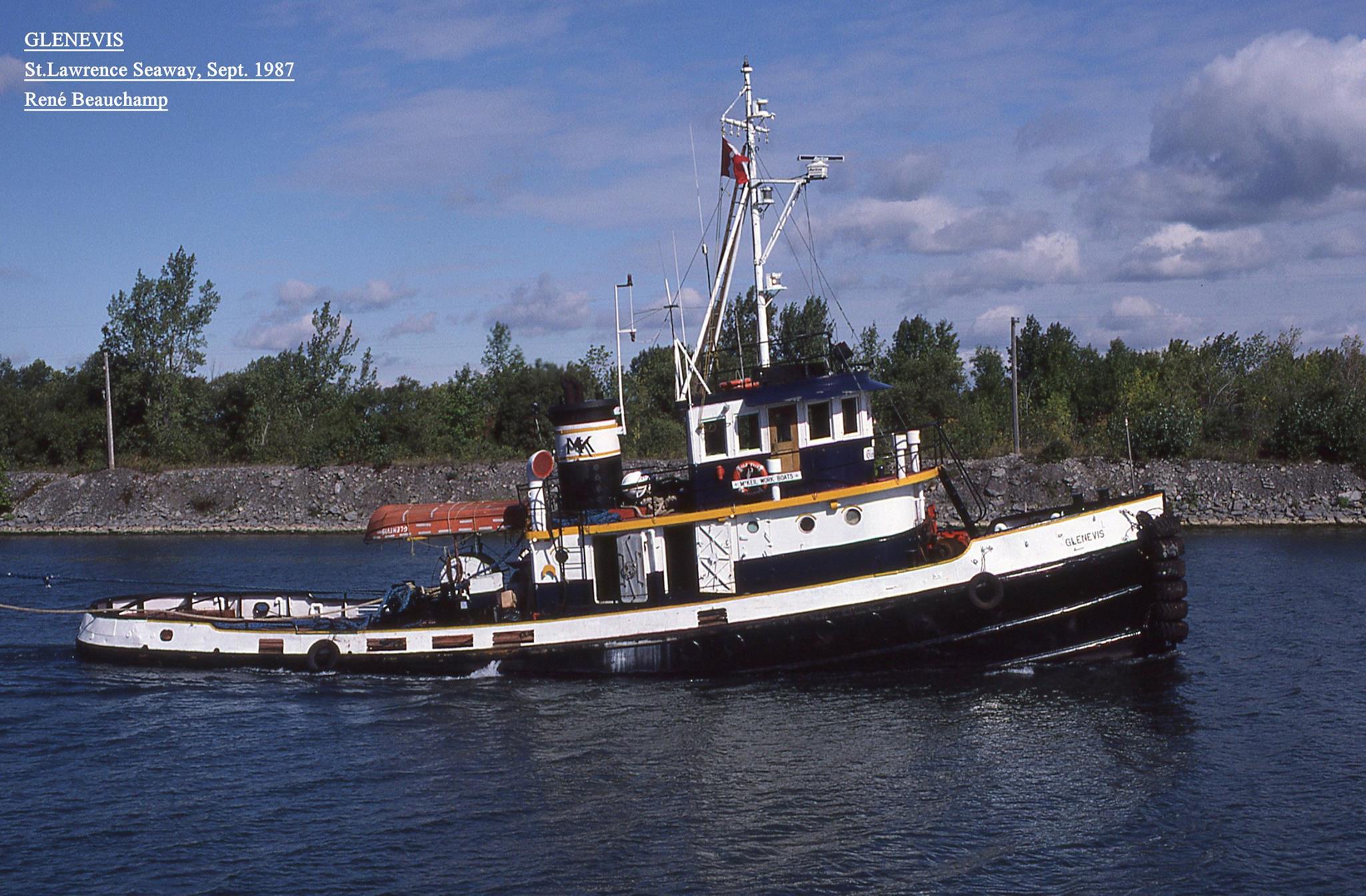
|
From a post by Bill Moran to the Toronto Marine Historical Society (July 18, 2019).
GEORGIAN BAY is shown in the Welland Canal on her long scrap tow from Thunder Bay to Aliaga Turkey. Photo date is July 16 1989. Tug GLENEVIS. (St. Catharines Standard photos, Skip Gillham collection).
The ship was built at Collingwood in 1954. She was ordered by Imperial Oil and what has been their fourth large crude carrier to operate between Superior, Wisconsin and Sarnia, Ontario. The Interprovincial Pipeline was completed in November 1953 and first oil reached Sarnia in January 1954 making the ship unnecessary. The hull was partially completed but she was redesigned and sold to Canada Steamship Lines who also owned the Collingwood Shipyard. The three other tankers were converted for various great Lakes operators and were considered successful ships. The GEORGIAN BAY because she was not a conversion had about a 10% greater grain capacity than the former tankers.
She operated until December 1982 when she laid-up at Thunder Bay. The lingering Great Lakes recession in shipping in the early 80's assured that she would not operate again.
In 1989, she was sold for scrap and was towed out of Thunder Bay by the Purvis tugs AVENGER IV and ANGLIAN LADY in early July. McKeil tugs GLENBROOK, GLENEVIS and STORMONT took her through the Seaway to Sorel. The Panamanian tug McTHUNDER towed the GEORGIAN BAY and her fleet mate SIR JAMES DUNN from Sorel on August 26 1989. The tow encountered heavy weather off the Azores in October and the DUNN broke loose and was recovered by another tug. The tow finally reached Aliaga on November 16 after more adventure than anyone bargained for.
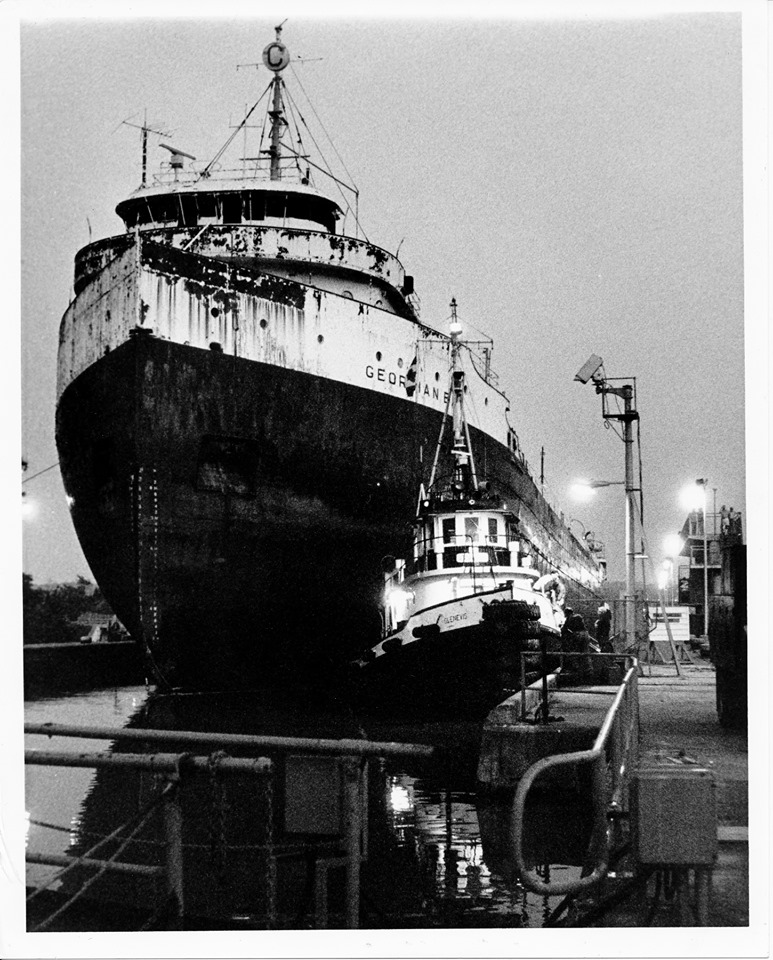 |
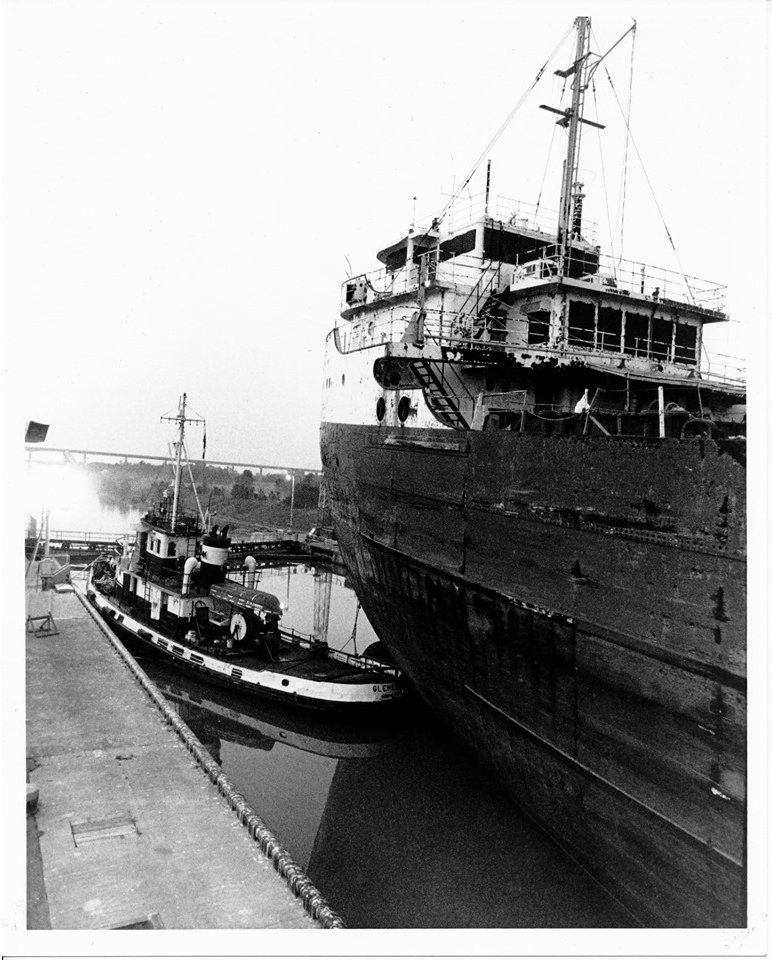 |
Glenevis sunk at Pugwash, NS, January 1, 1991, then was completely rebuilt.
Garth McKeil comments (Feb. 13, 2018): "Pugwash was dad's home town. If I recall correctly (without mentioning any names), he had arranged with one of his oldest friends (a local) to keep an eye on the boat while it wintered there. The story I got was that he removed a pump to work on it assuming the seacocks were closed. They weren't, only had a frozen line. The line thawed enough for the water to flow and it sank."
Tim McKeil comments "Re how the Glenevis sunk, story I recall was that Billie Moore had called from the airport saying that they had forgotten to lay up the sanitary pump seawater line. That information did not get to where it would do any good. The line froze, split, sunk the boat.
Glenevis was floated Jan. 9 by divers getting lifting straps around it, lifting it as far as was practical with a crane large enough for the job. Funny, I can't recall if we used one or two. Once up as far as practical, the divers (maybe me too, don't recall) jumped onto the boat and got suction hoses inside and started pumping, in time the boat floats, the leak is plugged, heat is brought to bear and the clean up and machinery repairs began.
Got the furnace going early on. Don't recall the use of a salamander, but I suspect that would been the initial heat source.
We used a generator on a dredge tied up ahead of the tug for electrical power for most of the job. I remember heating the oil filter with a propane torch in the morning before starting the unit. Then, we'd hold the engine speed down for about 5 minutes because the oil pressure would drop if the speed were allowed to increase. Straight 30 oil.
I had brought down 40 weight oil in Evan's Lariat pickup truck.
That oil was like grease. Never made that mistake again."
|
Glenevis with her new wheelhouse, Aug. 24, 1993 working in the Eisenhower Lock of the St.Lawrence Seaway, with the barge Black Carrier and the dredge Mercedes III. After sinking at Pugwash, NS, January 1, 1991, she was completely rebuilt.
source: http://tugfaxblogspotcom.blogspot.ca/2013/05/first-generation-glen-class-tugs-of-rcn.html
Glenevis in Port Colborne c. 1997. Photo by Albert Carlson.
Glenevis July 15, 1999. Skip Gilham photo courtesy Mac Mackay.
source: http://tugfax1.rssing.com/chan-8304477/all_p18.html
GLENEVIS. WINTER 2002 LAY UP TORONTO HARBOUR.
source unknown, dated 01/12/2002. 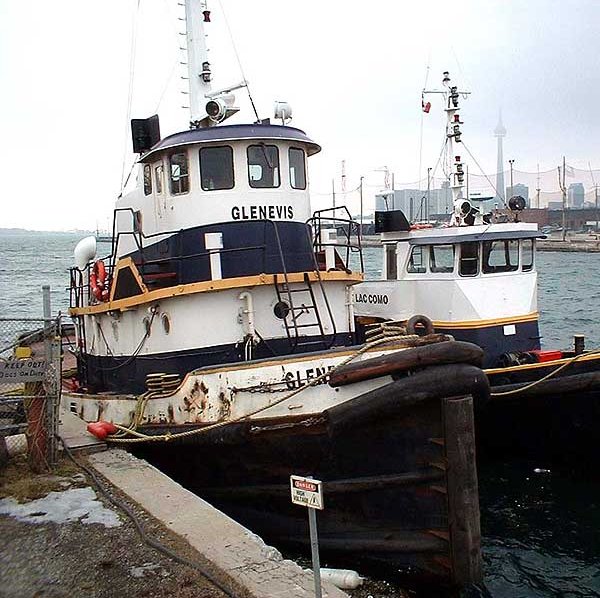 |
May 19, 2003. Atomic and Glenevis docked in Toronto Harbour next to the Southwest base of the Cherry Street bridge. The CN Tower can be seen in the background, peeking over the bow of the Atomic. Photo by John R. Southern via flickr.
https://www.flickr.com/photos/krunkwerke/229156866/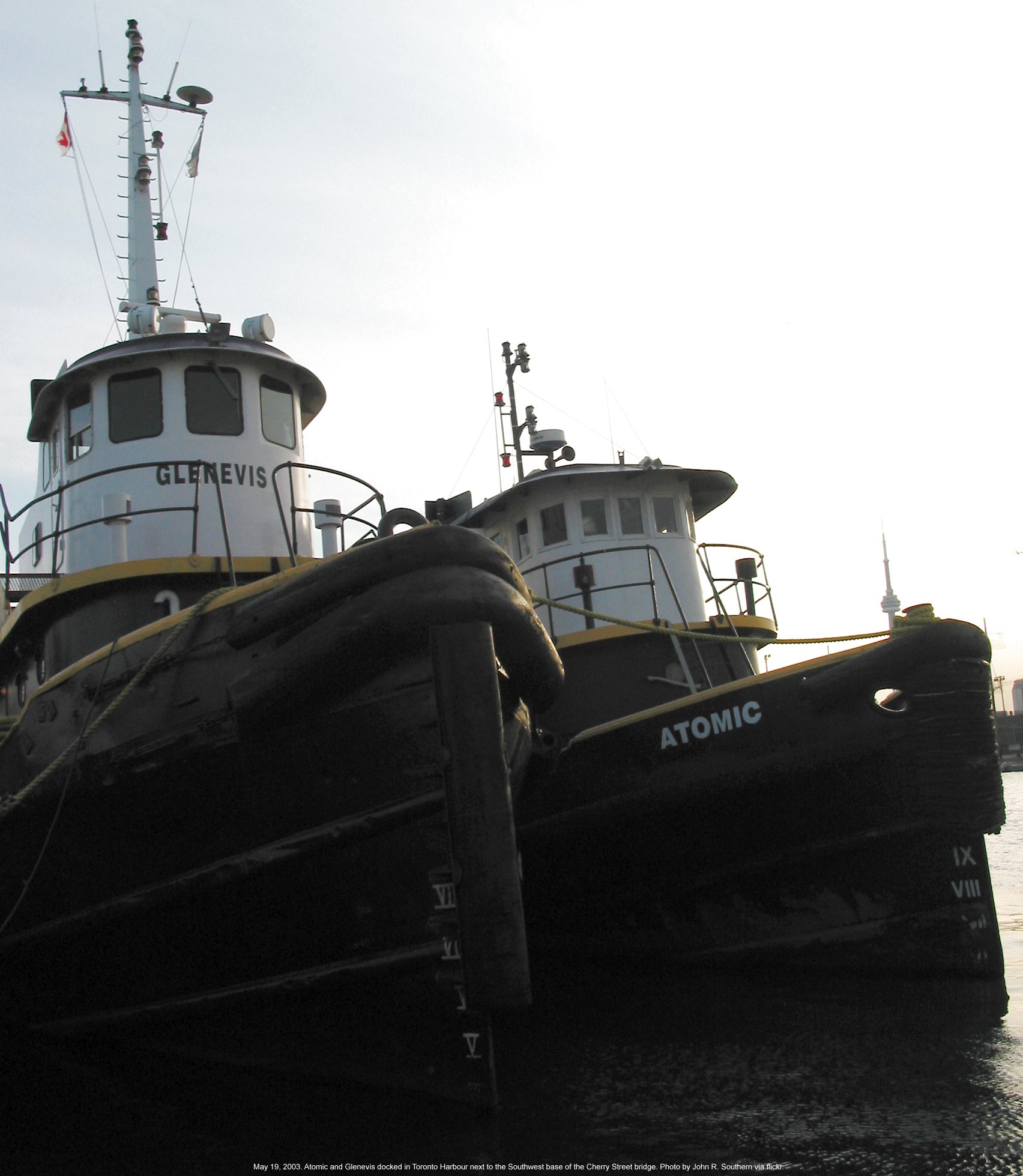
|
Gordon C. Leitch being pulled from the Port Weller Dry Docks, St. Catharines, ON by Alex Howard 9/19/04
(Sequence of photos showing the lakeboat being pulled from the dry dock by tug Glenevis assisted by tugs Progress and Vigilant I.)
boatnerd source: http://www.boatnerd.com/news/newsthumbs/newsthumbs_045.htm
Port Weller Dry Docks, St. Catharines, ON by Alex Howard 9/27/04
(Photo sequence of the dry-docking of the Jean Parisien by tugs Glenevis, Progress, and Vigilant 1.)
boatnerd source: http://www.boatnerd.com/news/newsthumbs/newsthumbs_054.htm
McKeil tugs Progress and Glenevis arrive to assist the Canadian Ranger from the dry dock. Canadian Ranger
leaving Port Weller Dry Docks, St. Catharines, ON by Alex Howard 10/06/04.
boatnerd source: http://www.boatnerd.com/news/newsthumbs/newsthumbs_062.htm
Christmas Day 2005 in the Welland Canal. Photo by Al Howard.
boatnerd source: http://www.boatnerd.com/news/newsthumbs/newsthumbs_189.htm
Glenevis Dec. 24, 2005, turning to go back to Lock 1 in St. Catharines. Photo by logan007 via flickr.
https://www.flickr.com/photos/logan007/3717317056/
|
ATOMIC AND GLENEVIS. WINTER 2006 LAY UP TORONTO HARBOUR, CHERRY STREET.
tugfest.net: Uploaded by: PROPROP [03-03-2006 20:48:24 EDT] 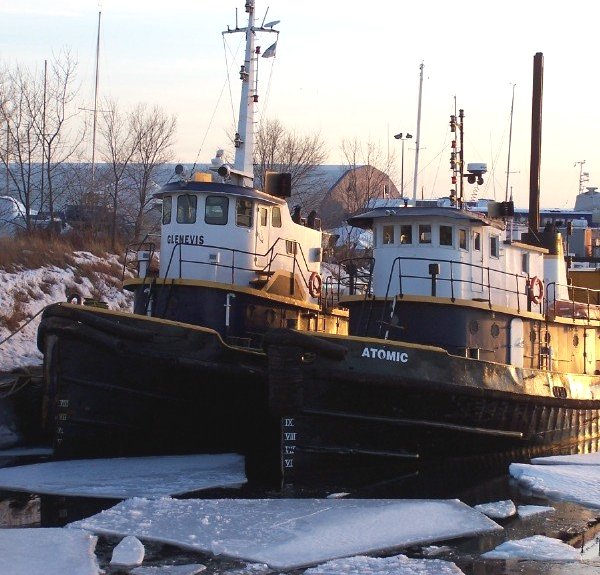 |
Glenevis at Port Weller Dry Docks, St. Catharines, ON in April, 2006.
Photo by Bill Bird, boatnerd.com.
From McKiel.com April 2007. More McKeil Russels: Atomic and Progress (ex P.J. Murer). 
Departing the lakes by way of the New York State Barge Canal. McKeil sold two of its tugs (Glenevis and Paul E. No. 1) off-lakes. They went to Oswego and down the barge canal, rumoured to be headed for Caribbean owners. Their registers closed June 26, 2007.
source unknown, via boatnerd.com. Gerry Ouderkirk Collection.
Tim McKeil comments (Feb. 13, 2018): "I believe Joe Chabot took the Glenevis down through the Erie Barge Canal to the buyer in New York. Staten Island or something. From there, could have gone anywhere south."
Hannay Suen built R/C models of Glenevis (foreground) and Angels Gate. Posted on facebook Tugboats & Other Remote Control Boats group Nov. 23, 2018.
For more Russel exhibits visit Owen Sound Marine & Rail Museum 1165 1st Ave West, Owen Sound, ON N4K 4K8
(519) 371-3333  http://marinerail.com http://marinerail.com |
|
|
|
|
|